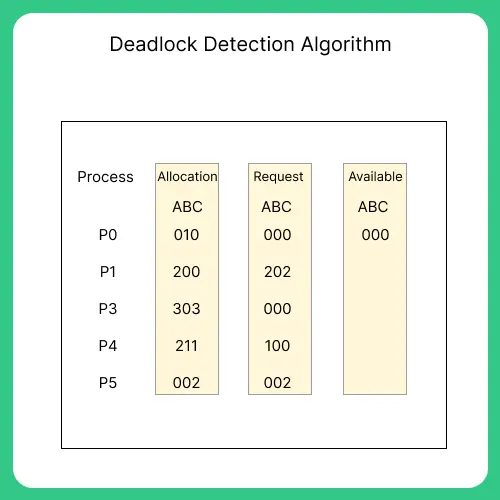Deadlock Detection Algorithm in Operating System

Deadlock Detection Algorithm in Operating System
Deadlock Detection Algorithm helps decide if in scenario of multi instance resources for various processes are in deadlock or not.
In cases of single resource instance we can create wait-for graph to check deadlock state. But, this we can’t do for multi instance resources system.
Algorithm Example
Do not confuse the deadlock detection algorithm with Banker’s algorithm which is completely different. Learn Banker’s Algorithm here.
The deadlock detection algorithm uses 3 data structures –
- Available
- Vector of length m
- Indicates number of available resources of each type.
- Allocation
- Matrix of size n*m
- A[i,j] indicates the number of j th resource type allocated to i th process.
- Request
- Matrix of size n*m
- Indicates request of each process.
- Request[i,j] tells number of instance Pi process is request of jth resource type.
Steps
- Step 1
- Let Work(vector) length = m
- Finish(vector) length = n
- Initialize Work= Available.
- For i=0, 1, …., n-1, if Allocationi = 0, then Finish[i] = true; otherwise, Finish[i]= false.
- Step 2
- Find an index i such that both
- Finish[i] == false
- Requesti <= Work
If no such i exists go to step 4.
- Step 3
- Work= Work+ Allocationi
- Finish[i]= true
Go to Step 2.
- Step 4
If Finish[i]== false for some i, 0<=i<n, then the system is in a deadlocked state. Moreover, if Finish[i]==false the process Pi is deadlocked.

Deadlock Avoidance Results
- Step 1
- Step 2
- Step 3
- Step 4
- Step 5
- Step 6
i=1 is selected as both Finish[1] = false and [2,0,2] <=[3,1,3].
- Step 7
- Step 8
- Step 9
- Step 10
- Step 11
Prime Course Trailer
Related Banners
Get PrepInsta Prime & get Access to all 200+ courses offered by PrepInsta in One Subscription





How to write the sequence in deadlock detection